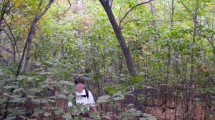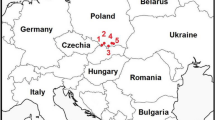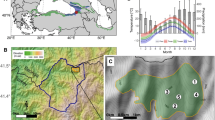Abstract
Gaps formed by stream laid gravels in a warm temperate Podocarp-Angiosperm rain forest in New Zealand were quickly invaded by 41 free-standing woody species. Height-age curves for the eight most frequent species were used to construct a 12 yr chronosequence which showed 18 species arrived by 0.9 yr and 33 by 1.9 yr. This rapid invasion was supplied from both gaps and mature forest and fitted the Initial Floristic Model coupled with a Facilitation Mechanism. Over the 12 yr period, stem density and births peaked at 0.9 yr and deaths at 1.9 yr with a natality of 39.5/m2, a mortality of 38.5/m2 and nearly 99% dying as seedlings. Plant height increased to 5.1 m at 12.1 yr with height increment peaking at 43 cm/yr at 7.3 yr. Maximum potential heights ranged from 4 to 60 m and were positively correlated with longevity which varied from 20 to 1150 yr for 19 known species. A decline in height increment to 0.9 yr showed a below-ground component in intraspecific competition with significant negative correlations between stem density and height indicating a later above-ground component. There was no significant height competition amongst the 11 most frequent species and only one significant negative interspecific association. This suggests high species coexistence for which ‘Equal chance’ was probably the major mechanism. Given this coexistence, rapid species arrival, early sexual maturity and similar density and height-age patterns, the main dynamic variables may be maximum height, longevity and height increment, all of which are, partly, genetically programmed. Most dynamic affinities are with tropical forest, although height growth and species richness are warm temperate.
Similar content being viewed by others
References
Allan, H. H. 1961. Flora of New Zealand. Vol. 1. Government Printer, Wellington.
Alvarez-Buylla, E. R. & Garcia-Barrios, R. 1991. Seed and forest dynamics: a theoretical framework and an example from the neotropics. Am. Nat. 137: 133–154.
Assmann, E. 1970. The principles of forest yield. Pergamon Press, Oxford.
Bray, J. R. 1989. The use of historical vegetation dynamics in interpreting pre-historical vegetation change. J. Roy. Soc. New Zealand 19: 151–160.
Brokaw, N. V. L. 1985. Treefalls, regrowth and community structure in tropical forest. In: Pickett, S. T. A. & White, P. S. (ed.). The ecology of natural disturbance and patch dynamics, pp 53–69. Academic Press, New York.
Clark, D. A. 1986. Regeneration of canopy trees in tropical wet forests. Trees 1: 150–154.
Cockayne, L. & Turner, E. P. 1928. The trees of New Zealand. Government Printer, Wellington.
Coulter, J. D. 1973. Ecological aspects of the climate. In: Williams, G. R. (ed.). The natural history of New Zealand. pp 28–60. A. H. & A. W. Reed, Wellington.
Dawson, J. W. & Sneddon, B. V. 1969. The New Zealand rain forest: a comparison with tropical rain forest. Pacific Science 23: 131–147.
Denslow, J. S. & Gomez Diaz, A. E. 1990. Seed rain to tree-fall gaps in a Neotropical rain forest. Can. J. For. Res. 20: 642–648.
Denslow, J. S. 1987. Tropical rainforest gaps and tree species diversity. Ann. Rev. Ecol. and Systematics 18: 431–441.
de Velice, R. L. 1988. Test of a tree dynamics simulator in New Zealand. New Zealand J. Bot. 26: 387–392.
Duncan, R. P. 1991. Competition and the coexistence of species in a mixed podocarp stand. J. Ecol. 79: 1073–1084.
Harper, J. L. & White, J. 1974. The demography of plants. Ann. Rev. Ecol. and Systematics 5: 419–463.
Hibbs, D. E. 1983. Forty years of forest succession in central New England. Ecol. 64: 1394–1401.
Hoppes, W. G. 1987. Pre- and post-foraging movements of frugivorous birds in the eastern deciduous forest woodland, U.S.A. Oikos 49: 281–290.
Knowles, B. & Beveridge, A. E. 1982. Biological flora of New Zealand 9. Beilschmiedia tawa (A. Cunn.) Benth et Hook. F. ex Kirk Lauraceae (Tawa). New Zealand J. Bot. 20: 37–54.
Lee, W. G., Allen, B. & Johnson, P. N. 1986. Succession and dynamics of gorse (Ulex europaeus L.) communities in the Dunedin Ecological District., South Island, New Zealand. New Zealand J. Bot. 24: 279–292.
Lieberman, D., Lieberman, M., Hartshorn, G. & Peralta, R. 1986. Growth rates and age-size relationships of tropical wet forest trees in Costa Rica. J. Trop. Ecol. 1: 97–109.
Loucks, O. L. 1970. Evolution of diversity, efficiency and community stability. American Zoologist 10: 17–25.
Matsuda, K. 1989. Survival and growth of Konara Oak (Quercus serrata Thumb.) seedlings in an abandoned coppice forest. Ecol. Res. 4: 309–321.
Moore, P. D. 1979. Next in succession. Nature 282: 361–362.
Ogden, J. 1985. Past, present and future: studies on the population dynamics of some long-lived trees. In: White, J.(ed.). Studies in plant demography. John L. Harper Festschrift. Academic Press, London.
Palik, B. J. & Pregitzer, K. S. 1993. The vertical development of early successional forests in northern Michigan, USA. J. Ecol. 81: 271–285.
Poole, A. L. & Adams, N. M. 1963. Trees and Shrubs of New Zealand. Government Printer, Wellington.
Rennison, G. & MacLeod, D. J. 1981. Native trees and shrubs for parks/reserves planting. Information Ser. 8, Dept. Lands Survey, Wellington.
Runkle, J. R. & Yetter, T. C. 1987. Treefalls revisited: gap dynamics in the Southern Appalachians. Ecol. 68: 417–424.
Salmon, J. T. 1980. The native trees of New Zealand. Reed, Wellington.
Seiwa, K., Kikuzawa, K. 1989. Seasonal growth patterns of seedling height in relation to seed mass in deciduous broad-leaved tree species. Jap. J. Ecol. 39: 5–15.
Smith, III, T. J. 1986. Precocious reproduction by gap dependent trees. p 317 in IV International Congress of Ecology Program.
Stewart, G. H. 1986. Forest dynamics and disturbance in a beech/hardwood forest, Fiordland, New Zealand. Vegetatio 68: 115–126.
Uhl, C. & Jordan, C. F. 1984. Succession and nutrient dynamics following forest cutting and burning in Amazonia. Ecology 65: 1476–1490.
Westman, W. E. 1990. Structural and floristic attributes of recolonizing species in large rain forest gaps, North Queensland. Biotropica 22: 226–234.
White, P. S. 1981. The adaptive geometry and life history of Aralia spinosa L., devil's walking stick. Bull. Ecol. Soc. Amer. 62: 73.
Williams, P. A. 1983. Secondary vegetation succession on the Port Hills, Banks Peninsula, Canterbury, New Zealand. New Zealand J. Bot. 21: 237–247.
Wilson, J. B. 1990. Mechanisms of species coexistence: Twelve explanations for Hutchinson's ‘Paradox of the Plankton’: evidence from New Zealand plant communities. New Zealand J. Ecol. 13: 17–42.
Wright, S. 1991. Regeneration strategies in main canopy and emergent tier rainforest tree species. New Zealand Ecol. Soc. Ann. Conference Notes, P 10. Nelson, New Zealand.
Author information
Authors and Affiliations
Rights and permissions
About this article
Cite this article
Bray, J.R., Burke, W.D. & Struik, G.J. Regeneration dynamics of alluvial gaps in a warm temperate rain forest in New Zealand. Vegetatio 112, 1–13 (1994). https://doi.org/10.1007/BF00045095
Accepted:
Issue Date:
DOI: https://doi.org/10.1007/BF00045095




